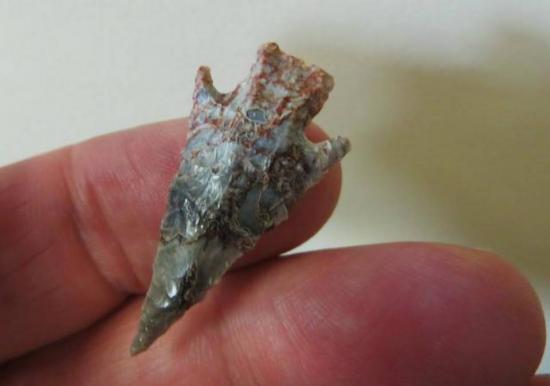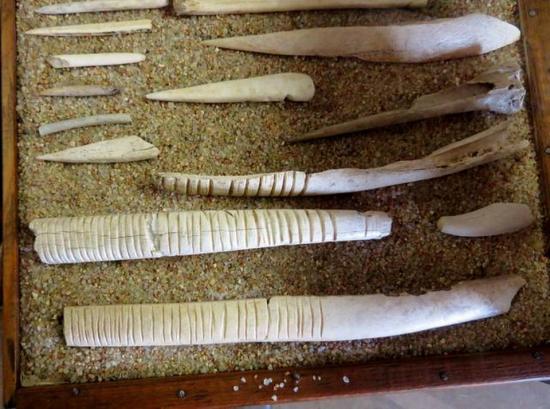Part.2

Turquois jewely, found in archaeological digs in Rice County Kan.. To obtain this turquois, archaeologist Donald Blakeslee said, traders for the ancestors of the Wichitas probably walked, with bison hide as trade goods and dogs as pack animals, all the way from Rice County to Santa Fe, a distance of more than 550 miles. In the Coronado Quivira Museum, Lyons, Kan.Roy Wenzl/The Wichita Eagle

Arrow point, of Alibates flint, still razor-sharp and deadly after hundreds of years, found in archaeological digs in Rice County, Kan. Ancestors of the Wichitas prized Alibates stone much, archaeologists say, that their artisans would hike 330 miles to obtain it, from a quarry in what is now the central panhandle of Texas. In the Coronado Quivira Museum, Lyons, Kan.Roy Wenzl/The Wichita Eagle

A flint awl, used for drilling holes in leather. To process bison hides, the ancestors of the Wichitas would use awls to drill holes in the outer edges of a hide, then stake down the hide to the ground, with the moist inner skin face-up. They would then scrape the hide with sharp flint scrapers attached to handles, removing gunk and thinning the hide. At the Coronado Quivira museum, Lyons, Kan.Roy Wenzl/The Wichita Eagle

Terri Parton, president of the Wichita and Affiliated Tribes, was deeply moved when she found sage growing beside the Serpent image in Rice County, during her visit in May. Some Wichitas still burn sage in cleansing rituals, she said; she wondered whether her ancestors planted it here hundreds of years ago for rituals alongside the image.Terri Parton/Courtesy

Arrowheads, knife blades, hide scrapers and other flint artifacts, made by ancestors of the Wichita tribe in Rice County, Kansas hundreds of years ago. The red-colored items at the upper right are tobacco pipes hand carved from Kansas pipestone. At the Coronado Quivira Museum, Lyons, Kan.Roy Wenzl/The Wichita Eagle

Tools made from bison bone fashioned in Rice County hundreds of years ago by ancestors of the Wichita tribe. The bones with cuts are rasps--a musical instrument. The user would place a rasp across the mouth of a cooking pot and run a wooden rod over it; the resulting echo-chamber grunt would mimic the deep grunt of a bison bull. At the Coronado Quivira Museum in Lyons, Kan.Roy Wenzl/The Wichita Eagle

Flint knife blade, hundreds of years old, held by museum visitor Kayla Hartje, 13, of Haven. In the collection at the Coronado Quivira Museum, Lyons, Kan.Donald Blakeslee/Wichita State University